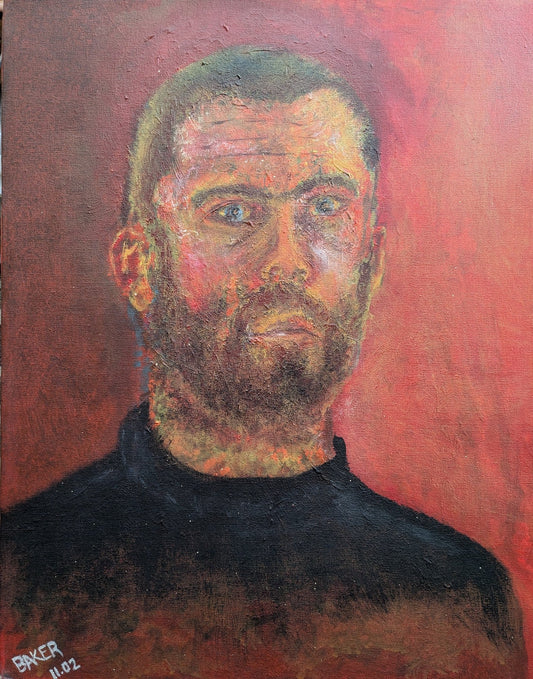Lanchen Mihalic is a 29-year-old multi-media cosmic artist who explores the infinite possibility of space and time with her art. Lanchen knew from a young age she wanted to be an artist, but she had wanted to be an astronaut since she was a kid. Lanchen found her niche by not sticking to one when starting her journey as a creative by exploring a plethora of creative endeavors to find what fits best for her. From special effects makeup to photography to modeling and set design, she pursued her interests by trying everything to find what clicked. However, that is how she stayed for a while—directionless.
“If I'm planning on doing this forever, then I need to have a path around a topic that I enjoy, that I'm passionate about, that I could grow a community around,” Lanchen said. That is how she found space. After growing up watching the launches in Florida and dreaming of being an astronaut, her journey in cosmic art started with a pair of shoes. One place we had in common was a fascination with galaxy-themed clothing. She started her journey in cosmic art by painting a galaxy on a pair of shoes, which took me back to a version of myself that was obsessed with galaxy-print shirts and shoes in the seventh grade.
The shoes were the first piece of clothing she painted with space prints on them. From there, the rest came naturally to her, moving onto canvasses and allowing herself to explore the infinite possibilities of the universe.
“I came back to space because I painted those shoes initially. I actually enjoyed it,” Lanchen said. “I liked it when I did it on the shoes, but when I converted it to canvas for the first time, I was like, wow, this is the most enjoyable process.”


Her next memorable defining moment was when she poured that first resin piece in 2018 and experienced the possibilities the medium had for cosmic art. “I literally cried. It replicates the gas so fabulously, so spot on. There's no other way to do that. I just felt so lucky to find that.”
From this resin revelation came collaborations with other artists. This was how she met Florida-based artist Jenna Lynn, who focuses her resin art on representations of the ocean. “I feel like the ocean and space are so similar. When I talk about space, people that aren't really into space always compare it to the ocean,” Lanchen said. The similarities have merit in that humanity knows so little about it. To Lanchen, this collaboration was a way for people from all understandings and fascinations with unknowns in space and the ocean to come together.


While the resin captures her visions perfectly, that detail comes at the cost of time. After our talk, I learned more about what her time scale is like for her pieces. Especially for resin, it is incredibly size-dependent. Her works around 4-12 inches long typically take a week to complete, and her larger ones can span across multiple weeks. Compared to a four-day to one-week time interval for completing a normal painting on canvas, this draws out the creation process and allows Lanchen to spend more time with each work, so she doesn’t experience artist’s block much.
When making these pieces, inspiration can come at any moment, but for Lanchen, her focus remains solely on the piece. While still taking time to challenge herself by copying an image, she finds the meaning behind her work to be lost in imitation. She finds herself immersed within the work with a clear head and lets whatever is meant to be there come to be, reflecting the nature of space on the canvas. Whatever is there has already happened, but a human understanding of it cannot be forced. Understanding will come naturally with time, much like Lanchen’s creative process for her art.
With that change, however, comes new technology, and Lanchen prefers to keep with the classics of space imagery. However, with the release of images from the James Webb Space Telescope, stars are now captured differently. Earlier images like the ones from the Hubble Space Telescope captured light from stars as having four points—James Webb’s captures six points. Lanchen prefers this four-point image. “People probably will start changing their stars because every image will start looking like that,” Lanchen said. While astrophotography refractors still capture the classic four-point star, they could become less frequent as innovations expand possibilities for telescopes in space and on the ground.
With a growing platform on Instagram and Tiktok and some exciting collaborations ahead, Lanchen continues to make resin-coated waves in the cosmic art scene. “It's all been worth it, obviously because I never thought I would be where I am today. So I'm glad that I kept going, but there was never really like an end goal in mind,” Lanchen said. “It's because if we're made of stardust, it's like, I am the universe creating the universe.” So what better way to give love to ourselves than by exploring these infinite possibilities through these cosmic self-portraits?
©ArtRKL™️ LLC 2021-2023. All rights reserved. This material may not be published, broadcast, rewritten or redistributed. ArtRKL™️ and its underscore design indicate trademarks of ArtRKL™️ LLC and its subsidiaries.





